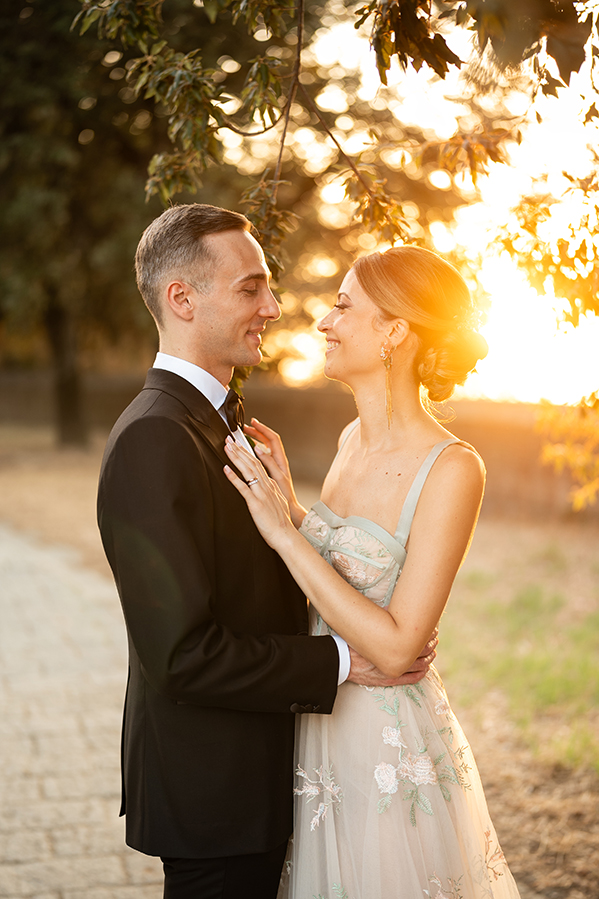Planning a wedding means making decisions that will significantly impact the entire event. Among these, one of the most strategic—and often underestimated—is choosing the time of the ceremony. Deciding whether to get married in the morning or the afternoon is not just a matter of style or venue availability: this choice deeply influences the atmosphere, guest management, and most importantly, the quality of wedding photography, which preserves the most lasting memories of your special day.
In this article, we’ll guide you through a complete reflection on how natural light changes throughout the day and the impact it can have on your wedding photos, helping you make the best choice for you as future newlyweds.
Morning wedding: natural brightness, a fresh atmosphere, and a relaxed timeline
Getting married in the morning offers several advantages, both from an organizational and photographic perspective. Morning light is one of its greatest strengths: it’s soft, diffused, and naturally bright, allowing the photographer to work in optimal conditions, avoiding harsh shadows or distorted colors.
The so-called “morning golden light” is softer than in the afternoon and helps create intimate and luminous images—perfect for couple portraits or for highlighting the bridal gown and floral arrangements.
From a climate perspective—especially in the summer—a morning wedding means enjoying cooler, more pleasant temperatures. This is no small detail: both the couple and the guests will feel more comfortable, resulting in more natural and spontaneous wedding photos.
Finally, a morning wedding allows for a more flexible reception schedule: for example, you can plan an elegant lunch followed by a long afternoon celebration, perhaps with a sunset cake-cutting moment, making the most of the evening golden hour as well.

Afternoon wedding: romantic vibes and picture-perfect sunset shots
Opting for an afternoon wedding is becoming increasingly popular—and for good reason. The main one? Sunset light, also known in photography as the golden hour. This magical window, from about one hour before to just after sunset, offers a warm, enveloping, and incredibly photogenic light.
Wedding photos at sunset are romantic, evocative, and full of emotion. Shadows stretch, colors deepen, and the atmosphere becomes intimate and almost dreamlike. It’s the perfect time for couple portraits: embracing against the golden backdrop of a fading sky is one of the most beloved images for those wanting to capture the essence of love.
Another benefit of choosing an afternoon ceremony is time management. Couples and guests can start the day slowly, prepare without rushing, and arrive at the ceremony already relaxed. Plus, evening receptions with music, soft lighting, and long celebrations are a natural fit for an afternoon wedding.

Timing and season: why every detail should be calibrated
Whether to marry in the morning or afternoon also depends greatly on the season. For example, in summer, a ceremony too early might mean a pre-dawn wake-up for makeup, hairstyling, and preparations. On the other hand, a winter wedding held late in the afternoon might end in darkness, limiting opportunities for natural light photography, which is one of the most desired styles among modern couples.
In the case of autumn or spring weddings, midday may offer the best compromise—not too early, not too late—providing the perfect balance between comfort and visual outcome.
Guest composition also plays a key role: if most attendees are families with children or elderly relatives, a morning wedding with a lunch reception may be easier to manage. For a young, dynamic couple who loves to party, the afternoon-evening format is usually the preferred choice.
Light as the leading role: the importance of your wedding photographer
No matter what time of day you choose to get married, remember one key thing: natural light is the photographer’s greatest ally. An experienced professional knows exactly how to harness morning light for soft portraits and sunset light for striking, emotional shots.
That’s why it’s crucial to discuss your schedule with your photographer during the planning phase. A skilled wedding and event photographer will advise you on the best timing not only based on light but also considering your chosen location, logistical needs, and the emotional tone you want your wedding story to reflect.
Together, you can define the perfect timing for couple portraits, preparation shoots, and the most scenic moments such as the cake cutting or the first dance. These discussions can make the difference between a “nice” photo set and a visually stunning and emotionally rich wedding album.

Conclusion: light, emotion, and thoughtful choices for a perfect wedding
Whether you’re early risers or evening atmosphere lovers, choosing the right time for your wedding ceremony is a decision that deserves careful consideration. It doesn’t just affect the mood of the event—it directly impacts the quality of your photographic memories, which will accompany you for a lifetime.Making a mindful choice also means honoring the work of those who will narrate your love story through images. Trusting a professional wedding photographer—someone who can read and use natural light in any condition—is the key to obtaining an authentic, emotional, and timeless wedding photography service.


Leave a reply